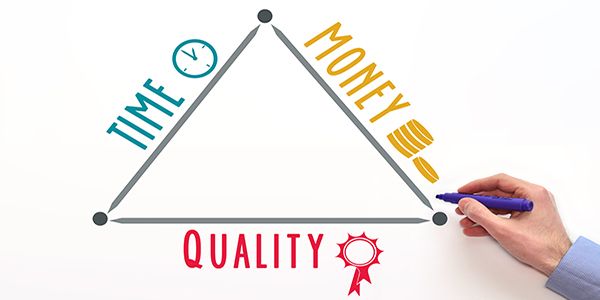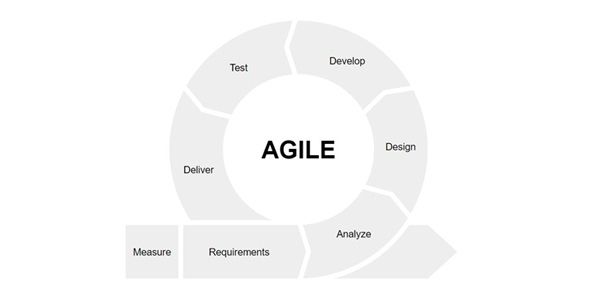How to Successfully Balance the Project Management Triangle
A project manager has to deal with many concerns simultaneously for project success.
The Project Management Triangle is associated with three major factors that affect the results of a project.
Three Points Of A Project Management Triangle Include:
- Cost
- Scope
- Time
These Three Constraints Are Interrelated. Let’s See How:
Let’s say your client asks you to expand the scope of a current project you are working on. Now, when the scope will expand, the time taken to complete the project as well as the cost incurred will also change. That is why the interdependence between these three factors makes them a project management triangle.
Creating a balance among these three constraints becomes very important for a project manager in order to deliver a quality product.
If we look at the following picture, you can see that quality is placed in the middle of the triangle while time, cost and scope are placed at the ends. It indicates that quality is a factor that cannot be compromised with or negotiated with, whereas time, cost and scope are negotiable or subject to change.
Why Is it Important to Manage This Project Management Triangle in a balanced way?
The three constraints of project management software have to be kept in mind from the very beginning of a project. Taking care of these helps the project managers adapt to the changing requirements of a project without affecting cost and the time taken.
This triangle of project management finds its reference in Agile methodology.
An agile methodology is an approach to project management which is based on the basic belief that changes are bound to occur in the way of software development or project completion. Any unforeseen situation during the project lifecycle can demand changes and adapting to these changes successfully ensures project success.
While the traditional methods of project management which are not flexible and do not adopt changes can result in failed projects.
When you are prepared to manage any unforeseen changes, the final output of a product is not jeopardized.
Let us have a detailed understanding of the project management triangle and how changes in any one of its constraints can affect the entire project.
Terms related to the project management triangle:
Scope
By scope, we mean all the work that has to be completed and all the services that have to be provided in a project. The entire spectrum of tasks is involved in it.
Now, an addition in the scope i.e. the amount of work would mean an extension of time required as well as the money spent on a project. Also, an addition to the functionalities would also require more resources which you might not have thought about at the time of planning.
The hiring of more resources for this project puts the project manager in a tight spot as the expenses as well as the development process lengthens up.
[widget id=”custom_html-68″]
Time
Time is one of the vertices of a project management triangle and plays a major role in deciding the success and failure of projects. Generally, at the beginning of a project, clients ask the question- how much time it will take to complete the project and what would be the exact cost?
Now, answering this question can be a little difficult for a project manager. A proper estimation of all other factors (resources, the type of project, potential bottlenecks etc.) becomes important to calculate time.
Cost
Cost is of paramount importance and if gone beyond the estimation can lead to a serious failure of a project.
Generally, cost is calculated for clients using the following formula
Service hours(h) * Rate per hour($ )= cost($)
Change requests or requests to add functionality can severely affect the cost of a project.
How to Strike a Balance in the Project Management Triangle?

Source: https://appinventiv.com/blog/how-to-balance-project-management-triangle/
Here are the approaches that project managers can use to strike a balance between the constraints of a project management solution.
Use a Project Management Software
A project management solution becomes a medium to make better time estimations, better cost estimations as well as defining the scope becomes easier.
Let’s understand in some detail.
Basically, project management solutions like BrightWork, ProofHub, Asana, Wrike etc. become a central place where you can plan, collaborate, discuss and get reports on your projects. Your entire team can contribute to project progress and give useful input without even the need to call meetings every time.
How a project management tool helps in balancing the PM triangle.
- It helps in planning your projects in a visual way using tools like a Gantt chart. You can keep all the project tasks against a timeline and see how much time each task will take. When all tasks are laid out in a timeline form, you can very well decide the resources required and the budget needed. Once clear on these parameters, you can communicate the same to the clients and also keep them in loop to maintain transparency.
- Apart from this, you can see bottlenecks or problem areas of your project while the project is in progress. All your tasks can be placed in the form of a board and you can see your tasks moving through various stages in real-time. This helps you ensure that you are not running behind the decided timeline so that the project does not get overdue.
- The readymade templates of project management software can help you plan your projects quickly without the need to start from scratch.
- Collaboration becomes effortless and clarity on roles and responsibilities is maintained.
- You can make changes in the schedule easily on a Gantt chart and everyone will be updated.
- Managers can get clear visibility into the workload of individual team members and make appropriate decisions.
Conclusion
Effective planning, clear visibility into the processes, the ability to make adjustments on the go can act as the hallmarks of maintaining a stable relationship among different constraints of project management.
Communication is yet another important factor that lets your projects not slip out of hands. When an effortless and effective communication is maintained among team members and managers at all times, the efficiency increases manifold and projects can be completed successfully within decided time frame and budget.











